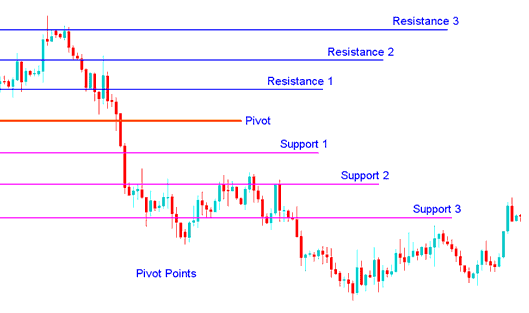Pivot Points Breakout Indicator
Stock Index Pivot Support & Resistance Trading Indicator Levels is a set of indicators used to determine potential turning points or potential indices breakout points, also known as " indices pivots" or pivot point. These Pivot Support and Resistance Zones are calculated to identify points where the market trend might shift from bullish to bearish or vice versa. Traders rely on these Pivot Support and Resistance Levels as key zones of support and resistance.
Pivot support and resistance levels are calculated using the average of the high, low, and close prices from the previous session.
Index Pivot Point = (High + Low + Close) / 3
Day traders analyze pivot points along with support and resistance levels calculated from indices to set entry points, stop-loss orders, and profit targets. This approach aims to anticipate market actions aligned with majority trading behavior.
A indices pivot point is a price level of significant analysis which is used by the traders as a predictive or leading indicator of price movement. Indices Pivot Support & Resistance Indicator is calculated as an average/mean of the significant prices (high, low and close price) from the trading market prior time period. If the market prices in the following trading price period trade above the central indices pivot point it is viewed as a bullish trend, whereas if price trade below the central indices pivot point level is viewed as bearish.
A central indices pivot point helps calculate additional support and resistance levels. These levels are determined by subtracting or adding price differentials derived from the previous day's range.
Indices pivot points and pivot-support/resistance levels often serve as crucial turning points in price direction movement.
- In an upward trend, the pivot point indicator & the pivot resistance levels - represent a ceiling level for the price - if price goes above this level the upward trend is no longer sustainable & a trend reversal is likely to happen.
- In a downwards trend, the pivot-point & the pivot support zones might represent a low for price level or a resistance to further price decline.
The central index pivot can then be employed in calculating the support and resistance areas as follows:
Index Pivot Support & Resistance Indicator Levels consist of a central indices pivot point level surrounded by 3 support levels below it and three resistance levels above it. Indices Pivot Support & Resistance Levels provide a quick method for stock traders to get a general idea of how the trading market will be moving during the course of the trading day by using a few simple math calculations which are based on the prior price close - Previous Day Close Breakout Strategy and Market Open Indices Strategies.
The Index Pivot Support and Resistance Indicator Levels can help you guess where prices might go in the future instead of just looking at what happened before. To figure out today's support and resistance points, you need the highest, lowest, and closing prices from the day before. These levels are worked out using specific formulas based on a full day cycle.
The central index pivot can then be employed in calculating the support and resistance areas as follows:
Resistance 3
Resistance 2
Resistance 1
Index Pivot Point
Support 1
Support 2
Support 3

Index Pivot Support & Resistance Levels - Indices Pivot Support & Resistance Indicator Levels
Examine More Educations & Subjects:
- How Do You Analyze Flag Pattern Index Setup?
- Trading the DJI 30 Index Using MT5 Software
- S and P Standard & Poor's 500 Trade
- Beginning an Index Platform Training and Learning Program
- MACD Stock Index Whipsaw Fake-Outs: How to Avoid Types of Stock Index Fake Out Signals
- Commodity Channel Index, CCI Index Indicator Analysis

